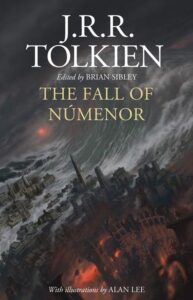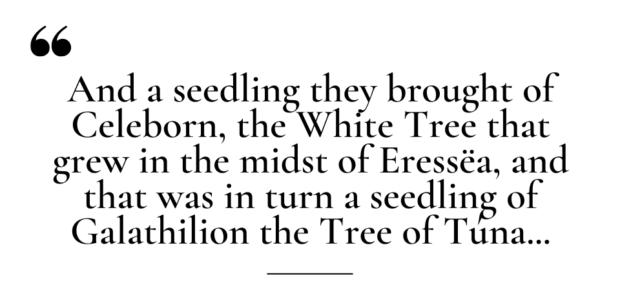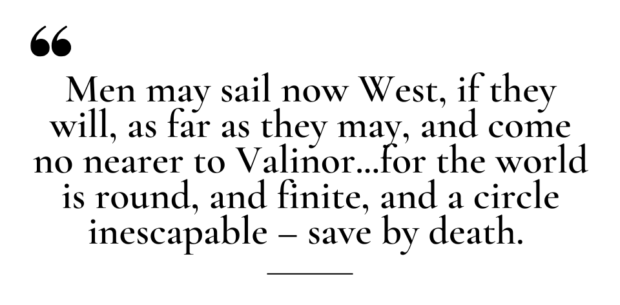Welcome back to The Read Goes Ever On: a casual and personal reading (and in some cases a very slow re-reading) of the works of J.R.R. Tolkien. Warning: there are minor spoilers for this book and The Lord of the Rings: The Rings of Power series in this review.
“The Second Age,” Tolkien once wrote to publisher Milton Waldman, “is on Earth a dark age, and not very much of its history is (or need be) told.” Despite this, some of it has been told. Yet as THE FALL OF NÚMENOR demonstrates, those tales have often been fragmented and hard to link.
When I started this column back in 2019, it had two simple purposes. It was partly to record my thoughts as I went through Tolkien’s works, but primarily to prepare myself for Amazon’s The Lord of the Rings: The Rings of Power by discovering those links between the Eldar Days and the more familiar tales. With this volume, we get a little bit of both.
On a basic level, editor Brian Sibley has compiled Tolkien’s scattered writings on the Second Age. The stories include the foundation of the island nation of Númenor, a brief history of their royal lineage, the forging of the Rings of Power, along with more familiar stories around the Last Alliance against Sauron that ended the Second Age.
Christopher Tolkien has kept his father’s legacy alive for decades for fans and scholars by meticulously recompiling his father’s unfinished writings. Through him, we discovered that The Lord of the Rings was part of a bigger story that started with the creation of world, and saw the rise of multiple evils before Sauron. Through him, we know more of The Silmarillion, Beren and Lúthien, the Children of Húrin, and the Fall of Gondolin. Following Christopher Tolkien’s death in 2020, writer Sibley has taken up that mantle.
THE FALL OF NÚMENOR is, for want of a better term, something of a mixtape. While not explicitly tied to the Amazon series, it’s clearly aimed at audiences who want to learn a little bit more about the Second Age without having to trawl through numerous texts, footnotes, appendices, and ephemera to do so. “The intention is not to supplant these works,” says Sibley in an introduction, “but rather to provide extracts…that illustrate in the author’s own words the rich and tumultuous events of the Second Age.” On this level, Sibley achieves something quite remarkable.
Using Tolkien’s The Tale of Years (first published in Appendix B of The Lord of the Rings) as a backbone, Sibley assembles pieces in their chronological order. Compiled from The Lord of the Rings, The Silmarillion, Unfinished Tales, volumes from The History of Middle-earth by Christopher Tolkien, and other sources, this represents the first time that this Second Age material has been presented in this way. Having (lovingly) laboured through a large chunk of those sources over the last three years, I found it refreshing to get some Númenórean lore in context.
In this volume, no longer is the island nation simply a place doomed to drown, or a series of relics scattered in stories and artefacts around Middle-earth. There are chapters on ‘The Natural Life of Númenor’ and ‘The Life of the Númenóreans.’ The complex relationship with the Elves is spelled out, as is Sauron’s growing interest and fear of Númenor as they take to the waves. We watch Sauron rise again, just as the Númenóreans push the limits of the ban of the Valar. We see how the Three Rings being forged, and ultimately the One Ring, was in parallel with the downfall of Númenor, the foundations of the empire in exile, and the Last Alliance of Men and Elves.
While not quite as structured as the Great Tales of the First Age, Sibley’s compilation gives these events weight and context. Due to the available material, there is a heavier emphasis than necessary on Tar-Aldarion, the sixth King of Númenor who is largely responsible for expanding the Númenor’s maritime traditions. While Tolkien was clearly compelled to write down his history in detail, Sibley’s presentation in this order also means that Aldarion dominates the middle section of the book. The Fall itself is almost an afterthought.
From a commercial point of view, this also represents something of a mixed bag for new initiates. Many will no doubt come to this off the back of The Rings of Power streaming series, but that too has taken its own liberties. Take for example the show’s character of The Stranger, which many have now guessed to be Gandalf based on lines in the first season’s final episode. Of course, the appendix to this book, which firmly reestablishes Gandalf’s first appearance as a Third Age event, kind of spears the idea in the torso. (That said, Amazon may just not care. Stay tuned on that).
Or you could just be as superficial as me and enjoy this book for Alan Lee’s new artwork. In addition to the magnificent plates and cover art that fully bring Númenor to life (and death), his pencil sketches are dotted all throughout the book. It not only illustrates these stories, but Lee’s presence lends them the legitimacy. They make these stories worthy of their place next to J.R.R. and Christopher Tolkien’s published works.
So, while it is slightly disappointing that THE FALL OF NÚMENOR represents almost entirely existing material, its unique presentation makes this a valuable piece of fictional history for fans and scholars alike.
In the last column, I bid ‘Namárië’ for now to The Read Goes Ever On. Yet it seems that one can never truly be done with Tolkien. If anything, this has me dangerously close to reading the History of Middle-earth series. Gulp. Yet I keep quoting the The Letters of J.R.R. Tolkien. When in doubt, always follow your nose.







